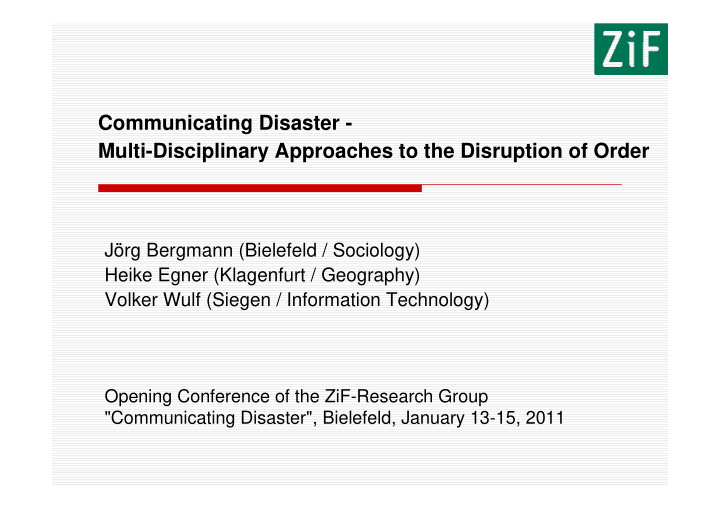



Communicating Disaster - Multi-Disciplinary Approaches to the Disruption of Order Jörg Bergmann (Bielefeld / Sociology) Heike Egner (Klagenfurt / Geography) Volker Wulf (Siegen / Information Technology) Opening Conference of the ZiF-Research Group "Communicating Disaster", Bielefeld, January 13-15, 2011
Overview 1. Disasters - and their communicative construction 2. The cycle of disaster communication Alarm communication and mobilizing help Focusing on disaster: Help organizations and media Evaluating disaster: Moral, religious and legal issues Risk communication: Preparing for the next disaster 3. Goals Combining micro- and macro-perspectives Stimulating interdisciplinary research Fostering cooperation between practitioners and researchers Moving towards a better theoretical understanding of disaster 2
1. Disasters - and their communicative construction • there is no such a thing as a “natural disaster” • communicating about disaster transcending boundaries: translocal and transnational contexts the media • communicating during disaster dimensions of extreme social change: “rapidity”, “radicalism”, “rituality/demonization” social embeddedness of disasters 1) type of societal order 2) involved social processes 3) involved actors and segments of participants 4) psychological, spatial and technical components 5) temporal structure and communicative strategies of coping 3
2. Cycle of disaster communication Focusing on disaster: Alarm communication / fighting and coping mobilizing help manifest disaster latent disaster Risk Evaluating disaster: communikation morality, religion, law 4
2.1 Alarm communication / mobilizing help Focusing on disaster: Alarm communication / fighting and coping mobilizing help Risk Evaluating disaster: communikation morality, religion, law 5
2.1 Alarm communication / mobilizing help • necessity to evoke collective reactions • what kind of support and which networks of information are needed? • open questions • which kind of help in which order? • processes of coordination? • role of new mobile technology? • ‘windows of opportunity’ for the mobilization? 6
7
2.2. Fighting and coping with disaster / media Alarm communication / Focusing on disaster: mobilizing help fighting and coping Risk Evaluating disaster: communikation morality, religion, law 8
2.2. Fighting and coping with disaster / media • communicative acts concerning disaster adaption on the side of victims on the helping side on the side of organized communication and decision-making • the role of the media and new information technologies 9
10
11
2.2. Fighting and coping with disaster / media • communicative acts concerning disaster adaption on the side of victims on the helping side on the side of organized communication and decision-making • the role of the media and new information technologies • research and methodological problems 12
2.3 Evaluating disaster: Moral, religious and legal issues Focusing on disaster: Alarm communication / fighting and coping mobilizing help Risk Evaluating disaster: communikation morality, religion, law 13
2.3 Evaluating disaster: monitoring, morality, religion and law • institutions and trainings to standardize the uncalculable • despite the rehearsals and pre-decisions: all can go wrong => communications on guilt, causation, responsibility and liability 14
2.4 Risk communication: preparing for the next disaster Fighting and Alarm communication / coping with disaster mobilizing help Risk Evaluating disaster: communikation morality, religion, law 15
2.4 Risk communication: preparing for the next disaster The foci of risk research: • risk estimation • risk perception • risk assessment • risk management • risk communication 16
17
3. Goals and objectives • Combining micro- and macro-perspectives • Stimulating interdisciplinary research • Fostering cooperation between practitioners and researchers • Moving towards a better theoretical understanding of disaster 18
19
Recommend
More recommend